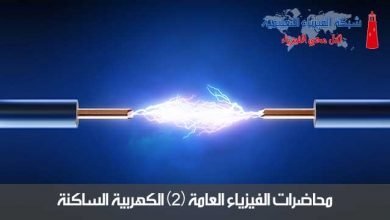محاضرة 10 فيزياء عامة (2) كهربية ساكنة أمثلة محلولة عن فرق الجهد الكهربي
أمثلة محلولة عن فرق الجهد الكهربي
Example 5.1
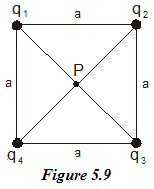 What is the potential at the center of the square shown in figure 5.9? Assume that q1= +1 x10-8C, q2= -2×10-8C, q3=+3×10-8C, q4=+2×10-8C, and a=1m.
What is the potential at the center of the square shown in figure 5.9? Assume that q1= +1 x10-8C, q2= -2×10-8C, q3=+3×10-8C, q4=+2×10-8C, and a=1m.
Solution

The distance r for each charge from P is 0.71m

Example 5.2
Calculate the electric potential due to an electric dipole as shown in figure 5.10.
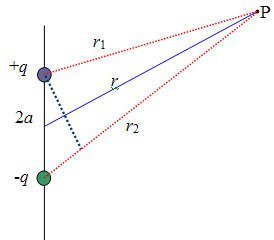
Figure 5.10
Solution
V = ∑ Vn = V1 + V2
When r>>2a,
r2 – r1 @ 2acosθ and r1 r2 @ r2,
where p is the dipole momentum
 (5.9)
(5.9)
Note that V = 0 when q=90o but V has the maximum positive value when θ=0o and V has the maximum negative value when θ=180o.
Example 5.3
Three charges are held fixed as shown in figure 5.12. What is the potential energy? Assume that q=1 x10-7C and a=10cm.
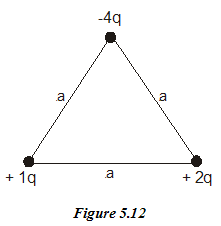
Solution
U=U12+U13+U23
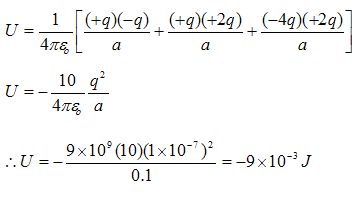
نلاحظ أن قيمة الطاقة الكلية سالبة، وهذا يعني أن الشغل المبذول للحفاظ على ثبات الشحنات سابقة الذكر سالب أيضاً. نستنتج من ذلك أن القوة المتبادلة بين الشحنات هي قوة تجاذب، أما في حالة أن تكون الطاقة الكلية موجبة فإن هذا يعني أن القوة المتبادلة بين الشحنات هي قوة تنافر.
Example 5.4
Two charges of 2mC and -6mC are located at positions (0,0) m and (0,3) m, respectively as shown in figure 5.13. (i) Find the total electric potential due to these charges at point (4,0) m. (ii) How much work is required to bring a 3mC charge from ¥to the point P? (iii) What is the potential energy for the three charges?
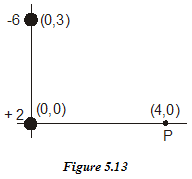
Solution
Vp = V1 + V2

(ii) the work required is given by
W = q3 Vp = 3 x10-6 x -6.3 x 103 = -18.9 x 10-3 J
The -ve sign means that work is done by the charge for the movement from ¥to P.
(iii) The potential energy is given by
U = U12 + U13 + U23

Example 5.5
A particle having a charge q=3×10-9C moves from point a to point b along a straight line, a total distance d=0.5m. The electric field is uniform along this line, in the direction from a to b, with magnitude E=200N/C. Determine the force on q, the work done on it by the electric field, and the potential difference Va–Vb.
Solution
The force is in the same direction as the electric field since the charge is positive; the magnitude of the force is given by
F =qE = 3×10-9 x 200 = 600×10-9N
The work done by this force is
W =Fd = 600×10-9 x 0.5 = 300×10-9J
The potential difference is the work per unit charge, which is
Va–Vb = W/q = 100V
Or
Va–Vb = Ed = 200 x 0.5 = 100V
Example 5.5
Point charge of +12×10-9C and -12×10-9C are placed 10cm part as shown in figure 5.14. Compute the potential at point a, b, and c.
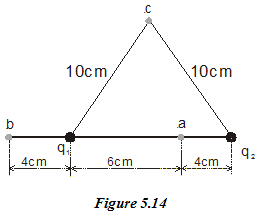
Compute the potential energy of a point charge +4×10-9C if it placed at points a, b, and c.
Solution
We need to use the following equation at each point to calculate the potential,
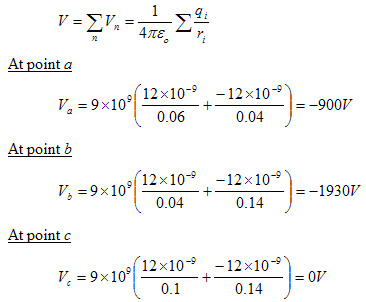
We need to use the following equation at each point to calculate the potential energy,
U = qV
At point a
Ua = qVa = 4×10-9x(-900) = -36×10-7J
At point b
Ub = qVb = 4×10-9x1930 = +77×10-7J
At point c
Uc = qVc = 4×10-9x0 = 0
Example 5.5
A charge q is distributed throughout a nonconducting spherical volume of radius R. (a) Show that the potential at a distance r from the center where r < R, is given by

Solution
لايجاد الجهد داخل الكرة غير الموصلة عند نقطة A مثلا فإننا سوف نحسب فرق الجهد بين موضع في مالانهاية والنقطة A.
![]()
وحيث أن للمجال قيمتين مختلفتين خارج الكرة وداخلها كما نعلم من مسألة سابقة من مسائل قانون جاوس.
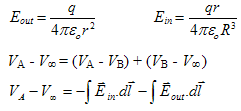
نلاحظ أن الزاوية بين dl & E هي 180o أي أن cos180= -1 ولكن أيضا dl = –dr

وهذا هو الجهد عند النقطة A وهو المطلوب إثباته
إذا كانت A على سطح الكرة فإن الجهد في هذه الحالة ![]()
أي كالجهد الكهربي لشحنة في الفراغ.
Example 5.6
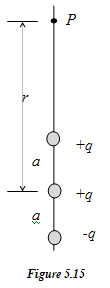 For the charge configuration shown in figure 5.15, Show that V(r) for the points on the vertical axis, assuming r >> a, is given by
For the charge configuration shown in figure 5.15, Show that V(r) for the points on the vertical axis, assuming r >> a, is given by
Solution
Vp = V1 + V2 + V3
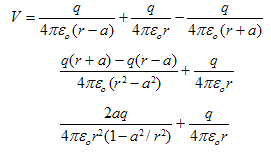
when r>>a then a2/r2 <<1

يمكن فك القوسين بنظرية ذات الحدين والاحتفاظ بأول حدين فقط كتقريب جيد
(1 + x)n = 1 + nx when x<<1

ويمكن إهمال a2/r2 بالنسبة لـ 1

Example 5.5
Derive an expression for the work required to put the four charges together as indicated in figure 5.16.
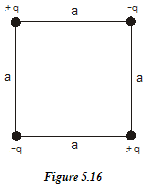
Solution
The work required to put these charges together is equal to the total electric potential energy.
U = U12 + U13 + U14 + U23 + U24 + U34
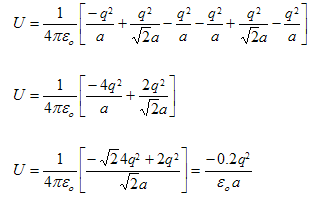
The minus sign indicates that there is attractive force between the charges
Example 5.5
In the rectangle shown in figure 5.17, q1 = -5×10-6C and q2 = 2×10-6C calculate the work required to move a charge q3 = 3×10-6C from B to A along the diagonal of the rectangle.
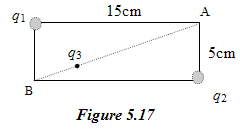
Solution
from the equation VB–VA = WAB / qo
VA= V1 + V2 & VB = V1 + V2
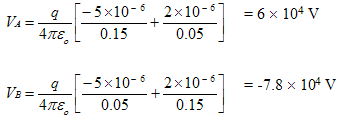
WBA = (VA– VB) q3
=(6 x 104 + 7.8 x 104) 3 x 10-6 = 0.414 Joule
Example 5.5
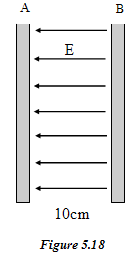 Two large parallel conducting plates are 10 cm a part and carry equal but opposite charges on their facing surfaces as shown in figure 5.18. An electron placed midway between the two plates experiences a force of 1.6 x 10-15 N.
Two large parallel conducting plates are 10 cm a part and carry equal but opposite charges on their facing surfaces as shown in figure 5.18. An electron placed midway between the two plates experiences a force of 1.6 x 10-15 N.
What is the potential difference between the plates?
Solution
VB–VA=Ed
يمكن حساب المجال الكهربي عن طريق القوى الكهربية المؤثرة على الإلكترون
F = eE → E = F/e
VB–V A = 10000 x 0.1 = 1000 volt


